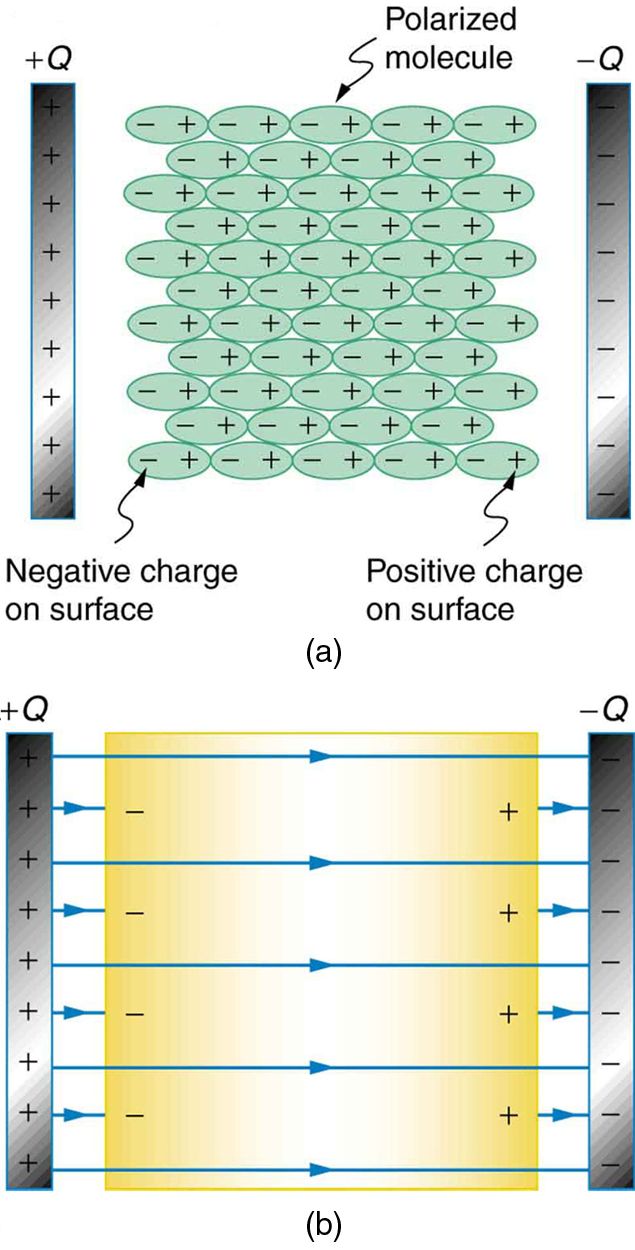2.3 Dielectrics
What Are Dielectrics?
Dielectrics are insulating materials commonly used in capacitors to enhance their capacitance. They address the problem of increasing the charge a capacitor can store without increasing its voltage. By introducing a dielectric, the capacitance is significantly boosted, making capacitors more efficient for various applications.
Revisiting Capacitance and Introducing the Dielectric Constant
From Section 2.2, we know the equation for capacitance without a dielectric:
When a dielectric is added between the plates, the equation modifies to:
Here, is the dielectric constant, a measure of the material’s ability to become polarized in an electric field. The higher the dielectric constant, the easier it is to polarize the material, which in turn increases the capacitance.

Common Dielectrics and Their Constants
The dielectric constant varies for different materials. The table below lists common dielectric materials and their constants:
| Material | Dielectric Constant (k) |
|---|---|
| Vacuum | 1 |
| Air | 1.00059 |
| Bakelite | 4.9 |
| Fused Quartz | 3.78 |
| Neoprene Rubber | 6.7 |
| Nylon | 3.4 |
| Paper | 3.7 |
| Polystyrene | 2.56 |
| Pyrex Glass | 5.6 |
| Silicon Oil | 2.5 |
| Strontium Titanate | 233 |
| Teflon | 2.1 |
| Water | 80 |
(Data from lumenlearning.com)
Why Does Adding a Dielectric Increase Capacitance?
The addition of a dielectric increases capacitance through polarization. Let’s break this down:
Polarization Effect:
When a dielectric is placed between the capacitor plates, its molecules align themselves in response to the electric field.
This alignment produces a surface charge on the dielectric that is opposite to the charge on the plates.
The opposing surface charge reduces the net electric field, allowing more charge to accumulate on the plates for the same applied voltage.
Reduction in Electric Field Strength:
The polarization of the dielectric reduces the overall electric field between the plates.
This, in turn, decreases the potential difference across the plates for the same charge, as:
Since capacitance is given by: a smaller results in a larger .
Visualizing the Dielectric Effect
Polarization in Action:
In the absence of a dielectric, the electric field between the plates is uniform.
When a dielectric is introduced, its molecules polarize, creating an internal electric field that opposes the external field.
This opposition weakens the net electric field, as shown below:
Images:
(a): Molecules polarizing and aligning in opposition to the plate charges.
(b): Reduced field lines due to polarization.
Practical Implications
By using dielectrics, we can:
Increase Capacitance: Higher values enable capacitors to store more charge.
Improve Efficiency: Dielectrics reduce energy losses in systems by minimizing electric field strength.
Enhance Device Performance: Many modern electronic devices rely on high-capacitance capacitors for efficient operation.
Practice Problem: Cylindrical Capacitor with a Dielectric
Problem Statement:
A capacitor consists of two coaxial cylindrical shells with radii and , and length . The space between the cylinders is filled with oil having a dielectric constant . Initially uncharged, a battery is used to charge the capacitor, leaving on the inner shell and on the outer shell.
Part (a): Using Gauss’s Law, determine the electric field midway along the length of the cylinder for:
Part (b): Calculate:
The potential difference across the capacitor.
The capacitance of the capacitor.
Solution:
Electric Field Inside the Dielectric:
Using Gauss’s Law:
Electric Field Outside the Capacitor:
The total charge enclosed is zero, so:
Potential Difference:
Integrating the electric field:
Capacitance:
From the definition of capacitance:
Conclusion
Dielectrics play a critical role in enhancing the functionality of capacitors. By increasing capacitance, reducing electric field strength, and improving overall efficiency, they are indispensable in modern electronics. Whether used in high-voltage power systems or micro-scale circuits, understanding the role of dielectrics is essential for advancing technology. Use the practice problems to deepen your understanding and stay tuned for further insights!







